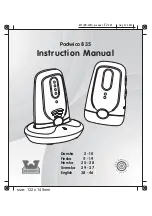
CHAPTER 6. TROUBLESHOOTING
This chapter describes some common problems
you may encounter while using Microcells™. For
each problem, one or more possible explanations
are listed. An indication of when the problem is
likely to be noticed and suggested solutions are
provided for each explanation.
PROBLEM 1. SMALL AMPLITUDE
CHANGES OR ERRATIC
FLUCTUATIONS IN DISPLAY
READINGS.
EXPLANATION
Small amplitude drift or oscillation, with
peak-to-peak disturbance of 0.1% to 0.3% of full
scale, is normal.
Problem Likely to be Noticed
Shortly after initial installation.
Solution
Reduce or eliminate drift or oscillation by
setting “count by” and “averaging”
appropriately on signal processor (refer to
signal processor manual).
EXPLANATION
Fluctuations can be caused by moisture in cable
conduit, junction boxes, or printed circuit boards
(PCBs).
Problem Likely to be Noticed
On system that previously functioned correctly.
Solution
Check conduit, junction boxes, and PCBs for
water contamination. Find water entry source
and correct problem. Dry with a hair dryer.
Remove/replace corroded parts and materials.
CAUTION
If using a sealant to eliminate water entry,
use Sikaflex 1A polyurethane sealant or Dow
Corning RTV 738 or RTV 739
. Other sealants
may contain acetic acid, which is harmful to
sensors and electronics.
EXPLANATION
Fluctuations can be caused by a damaged
Microcell™.
Problem Likely to be Noticed
Shortly after initial installation or on system that
previously functioned correctly.
Solution
Using Digital Multimeter (DMM) or ohmmeter,
check resistance for individual Microcells™:
1. Set meter resistance scale to accommodate
measured range up to 20,000Ω.
2. Remove one Microcell™ wire from junction
box terminal TB3.
3. Put one DMM lead on the white wire of the
Microcell™ and other DMM lead on the red
wire of the Microcell™. Record resistance
and verify it is within following limits:
A. 3” standardized Microcell™ (light blue
cover) - between 8,300Ω and 8,700Ω
B. 2” Microcell™ and 3” non-standardized
Microcell™ (dark blue cover) - between
1,800Ω and 2,200Ω
If reading is outside this range, the
Microcell™ is damaged and must be
replaced.
4. Put one DMM lead on the white wire of
the Microcell™ and other DMM lead on the
black wire of the Microcell™. Record
resistance and verify it is within following
limits:
A. 3” standardized Microcell™ (light blue
cover) - between 8,300Ω and 8,700Ω
B. 2” Microcell™ and 3” non-standardized
Microcell™ (dark blue cover) - between
1,800Ω and 2,200Ω
If reading is outside this range, the
Microcell™ is damaged and must be
replaced.
5. Verify readings from Steps 3 and 4 are within
140Ω of each other. If not, the Microcell™ is
damaged and must be replaced.
6. Repeat Steps 2 through 5 for each suspect
Microcell™, until damaged Microcell™ is
located.
29
Содержание Microcell
Страница 20: ...Figure 3 18 Cutting Wrap Width Figure 3 19 Installing Brace Wrap 16 ...
Страница 22: ...Figure 4 2 Microcell Mounting Locations 18 ...
Страница 30: ...Figure 4 16 Wiring Junction Boxes Together Non Conduited Installation 26 ...
Страница 37: ...33 ...
Страница 42: ...38 ...
Страница 43: ......












































